M.Tech graduate quits job, delves deep into trade and creates local employment
By B.C. Thimmaiah
[Photos and inputs by M.N. Lakshminarayana Yadav]
For thousands of years, fats and oils have been important in food preparation and many natural oleaginous materials such as sesame, mustard seeds and coconut were known sources of oil. Juices and oils were extracted from vegetables as early as 1500 BC using either a mortar and pestle or a grinding stone working on a flat stone. This system of oil extraction through cold-press method is known as ‘Gaana’, or ‘Ghani’ or ‘Marachekku’.
Cold-pressed oils are gaining popularity now-a-days with people realising their benefits over refined ones, so is the process of making these wooden oil mills operated by a pair of bullocks. The increasing demand for cold-pressed edible oils has brought good demand for making of wooden oil mills and individual farmers are taking to this form of producing oils. Many software professionals too are getting into natural farming and using this as value addition to their produce.
From M.Tech to oil extraction
Tucked away in a quiet nondescript hamlet named Nelamane in Srirangapatna taluk of Mandya district, M. Kamalesh, an M.Tech graduate from BMS College of Engineering, Bengaluru, is doing steady business these days. He has given up his thriving profession in New Delhi and Bengaluru and has opted for organic farming and has established oil-extracting machines at his place.
Cooking oils people use these days are processed with various chemicals and also under high temperature. Much of the healthy ingredients like antioxidants and vitamins are lost when any cooking oil passes through several chemical and heat treatment units. Kamalesh extracts oil in natural ways without using heat or chemical processing systems.
“In modern terms, it is called cold-pressed oils. As no chemical is used, or the seeds and nuts are not processed under strong heat, the extracted oils contain all natural properties. People have realised that such oil extraction process retains healthy antioxidants,” he says.
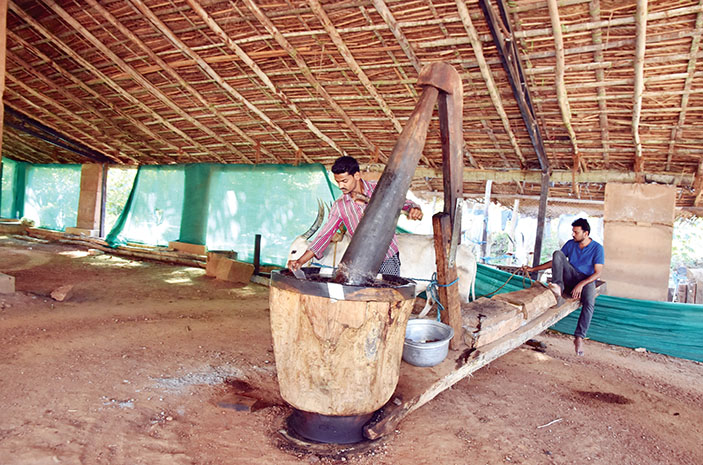
Simple equipment
‘Gaana’ is a single angled piece takes the form of two shorter pieces pinioned or chained together. The bottom of the lower angled piece is attached to a load-beam where one end of the load-beam rides around the outside of the barrel while the other is yoked to the animal.
The load-beam is weighed down with either heavy stones or even the seated operator. As the animal moves in a circular ambit, the pestle rotates, exerting lateral pressure on the upper chest of the pit, first pulverising the oilseed and then crushing out its oil. The wooden equipment has a capacity of 8 to 15 kg, has an oil outlet at the base of the pit (which is kept plugged during crushing) and frequently has the operator seated on the load-beam.
Kamalesh extracts oil from Groundnut, Coconut, Sesame, Niger seeds (huchhellu), Castor (Haralenne) and Safflower (Kusube or Kusuma Yenne). To extract oil, he employs Hallikar breed of bulls as they are more found in the traditional Hallikar belt of Mysuru, Mandya, Hassan and Tumakuru districts.
Long, vertical and backward bending horns, large humps in males, moderate to long height and medium size of the body, and white to grey and occasionally black complexions are the characteristics of the breed. The bulls of this breed of cattle are known for their strength and endurance.

Creating local employment
Kamalesh was attracted to rural life since his high-school days. Though a tech graduate, he was always nursing the dream of relocating to his village where his grandparents lived to revive traditional practices.
“At Nelamane, I have over 20 Hallikar bulls and over eight workers help me. There are four Gaanas as of now and two more will be added in a couple of months. All the workers are full-time and I also employ many people from the village based on orders, thereby creating local employment. It’s my way of being Aatma Nirbhar,” he says.
Kamalesh is a first-generation youth who has taken up this business and no one in his family or his village have done this before. “I met many people and visited many places to learn the tricks of the trade. We started with trial-and-error method after creating the ‘Gaana’ and it clicked. I read a lot of literature, collected photos, videos and descriptions of bull-driven oil extractors and created the equipment using locally-available wood,” he reveals.
He has not obtained any formal or informal training to extract oil. “We experimented a lot and every day is a learning process. Now we are in a position to repair the equipment ourselves as wood will undergo frequent wear and tear,” he says confidently.
After he proposed the idea of starting Gaana cottage industry, like-minded college friends invested in the project. Kamalesh took training at the Indian Institute of Management Bangalore (IIMB), to launch the small-scale unit.
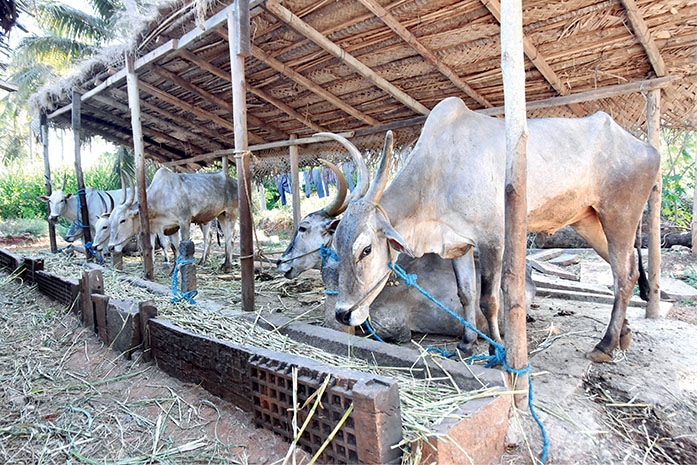
Bull-driven oil
Oil extraction is a painstaking process and one schedule or a batch will take two to two-and-a-half hours. “A big Gaana can crush 18 kgs of seeds while a smaller Gaana can crush 10 kgs. We have both the varieties. Our firm’s name is Grassroots Organic and we have named our oil brand as Bull-Driven Oil,” Kamalesh explains. Once the oil is extracted, the oil cakes are packed and sent as animal feed. There is good demand for this too, he adds.
The wood used in the construction of the Gaana machine, requires high craftsmanship. Also, the constant friction caused by rotation, wood and other elements are subjected to wear and tear which need regular maintenance. The rock used in the Gaana is typically carved out of a single heavy rock. “Any fraction of error leads to non-functioning of the Gaana. Everything should be in perfect synchrony,” explains Kamalesh.
He uses traditional method, ensures that the seeds are crushed under low temperature. This retains the quality and aroma of oil.
Kamalesh sources the best seeds for oil extraction. “I don’t go to the open market to buy seeds but I depend on a steady supply network through my friends and contacts. For example, I get regular supply of groundnut from North Karnataka and my friend sends it. All the seeds are carefully selected and the impurities are sifted out. We do not crush seeds for others and supply oil. We do it based on our needs and orders,” he says.
Flavour of oil
Years ago when oil extraction was widespread, fresh oil was in great demand than it is today. Flavour, which is an important attribute of all oils, is best in oils produced naturally through crushers. Both storage quality and nutritive value are high. “Today home-makers, especially in urban areas, demand bland and refined packaged oils that are extracted using machines. Our oils are sold directly to customers and we have a wide customer base in Mysuru and Bengaluru,” he reveals.



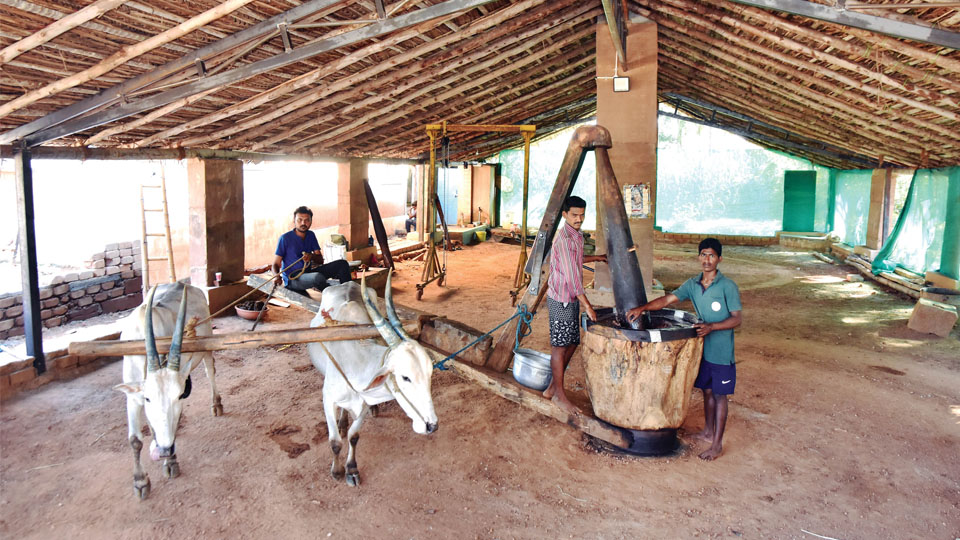

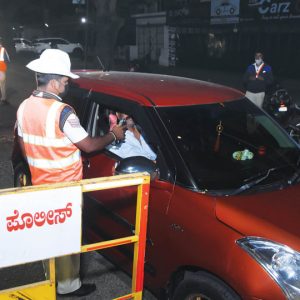

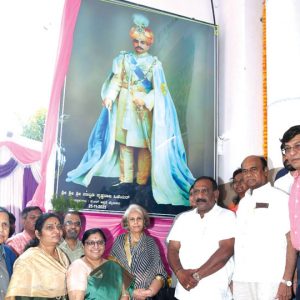
Some 50 years back, there was a ‘Ganada yenne co-operative society’ selling ‘Ganada yenne’
It was in Shivaram pet. I wonder what happened to it?
This is torture for the bullocks, which are normally put down, after a few days in the Ganas, as their necks got bloodied , hence they suffered, and did not last long working hard at the Gana. A torture it is, and hence the dozen or so Ganas in Mysuru, were phased out. This is cruelty to the animals, and should be banned..
Dear Kamalesh,
You are a M.tech graduate. Please do not use the animals for whom the burden on the neck and the repetetive circular motion is detrimental to their health. I recognize that the oxen have been and continue to be used to ‘plough fields’ and though it is also a rigourous activity it happens only a few times in a year. I am not condoing ploughing but recognize it as an activity for which we still dont have a ‘green/natural’ energy source machine.
Kamalesh, with your technical expertise and business savy skills, banks should be persuaded to provide you a favorable loan to install solar panels on the huge roof of your oil mill. Please generate the electricity and invest in a motor to run the crusher. It will be good for everyone.
I am proud of your efforts to produce ‘natural’ food products for human and animal consumption.
Thank you.
Can I get contact details? Or cal me back on 9008588337